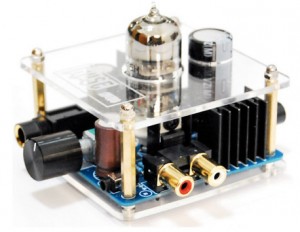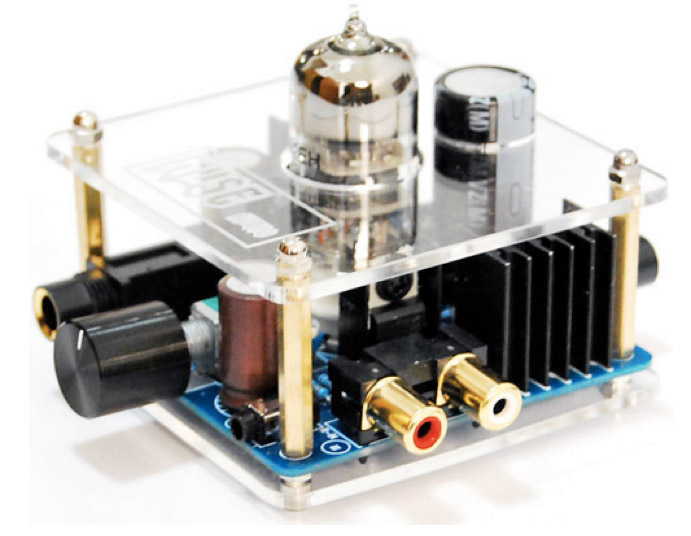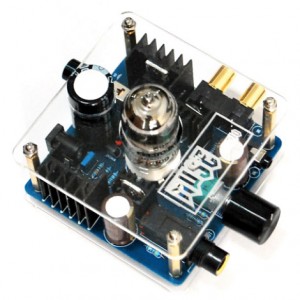From the time I was a kid I was fascinated with vacuum tubes. Maybe it was the filament glow coming from the otherwise darkened cabinet, or the precision of having to set the pins in just the right direction. Whatever the case may be, I could not help to have a passing thought of Thomas Edison going thru hundreds of different filament materials before finding one that actually worked. Move ahead to FDR’s fireside chats and the tens of millions of Americans who found hope in the warmly conveyed words of the President thru a tabletop radio-vacuum tubes and their yellowish glow unquestionably bespeaks “Americana.”
Specifications:
Frequency response: 10Hz-60KHz +/- 0.25dB
Signal/Noise Ra@o: >91dB
Dynamic range: 84.6dBA(300 ohm) 89.8dBA(33 ohm)
THD: 0.016%(300 ohm) 0.45%(33 ohm)
IMD + Noise: 0.045(300 ohm) 0.42(33ohm)
Dimensions: 79mm (D) X 79mm (W) X 44mm (H) // 3.1” x 3.1” x 1.75”
Shipping Weight: 0.55 kg // 1.2 lbs.
Muse 6N11 review
Fast-forward to now. Much like the rotary-dial telephone, today’s youth don’t have that connection. The Muse 6N11 headphone amplifier’s an intriguing curiosity that can bridge that gap. With a budget-friendly price of just $49.99, at the very least it’s a fun and inexpensive distraction. Put another way, it represents an entrance to the vacuum-tube audio world for the price of a round of golf. The Muse 6N11 with its clear top and base along with open sides begs to be explored, touched, and, in the case of some DIY forums, modified.
For our purposes here the goal is simply to answer the basic question,
“Does the Muse 6N11 give the listener a sampling of what vacuum tube headphone sound offers in comparison to solid state and chip amplification?”
However, before getting into the all-important sound, let’s quickly explore the physical side of things. The Muse 6N11 takes up 3.1 square inches and stands 1.75 inches tall… except for the tube, which adds another inch. To put it another way, the Muse 6N11 is about the size of a serving of lasagna.
Without typical box construction, I’m sure an owner will find themselves as I did constantly trying to orient themselves to the unit’s sides. The obvious giveaway for the front is the mini-headphone jack, the ALPS volume knob seated center and the 3.5mm input on the right. Rotating 90° to the left and just inside is a hard-to-spot vertical black button that switches between the RCA and the 3.5 inputs. On the back are the RCA left/right input jacks, then a small silver toggle that acts as the POWER switch. On the right side of the 6N11 is a pair of RCA output jacks.

The board itself is jammed full of various electronic parts including Elna, Wima, and Panasonic. The 6N11 socket sits dead center. An unsuspecting user can foolishly assume that by avoiding the tube that one could grab the Muse 6N11 without being burned. Wrong! Just behind and to either side of the tube lay two large heat sinks that go to the edge of the casing. Interestingly enough, the clear plastic does a fine job of dissipating heat, however, the plastic does give off some sort of fume that clouds the tube. Four small leg bolts, the bottom covered with rubber feet, support the unit.
Listening Muse 6N11
Out of convenience and to be fair to the ALPS volume control, I used the RCA analogue output of the iPod-connected Wadia 170i sent directly into the RCA input of the Muse 6N11. No DAC was placed between as I decided that this would be the typical configuration. Right off the top the Muse 6N11 presented a fairly noisy background. This was the result of a desktop computer on the same surge suppressor strip. Therefore, fair warning to all to seek out a “quiet” socket connection. Once eliminated, a quieter background appeared, but I still let the unit burn-in 24/7 for ten days.
The manufacturer Muse-Audio recommends powering the amplifier for 20 seconds before plugging in the headphone or turning on the power amp, if using the Muse 6N11 as a preamplifier. I used a sticky note to remind myself to follow this procedure.
In comparison to the Topping TP30/31, the Muse 6N11 does offer a warmer presentation, not a surprise with the tube glowing seductively. I did detect some crosstalk between channels alongside a less quiet background while listening thru my Sennheiser HD650 headphones. Never lose site of the fact that audio products under $2000 are going to have limitations, therefore, at just fifty dollars, perspective is in order.
 To see how the mellow Muse 6N11 can make a recording sound good, I selected Kamakiriad from Donald Fagan. Many in the audio community, myself included, consider this to be a “hot” recording especially in the upper treble. The Muse did a fine job of calming down such intense tracks as “Countermoon” and “Tomorrows Girls.” Along with the tamping down of the top end, the bass suffers from mushiness. Even with that, Kamakiriad was an enjoyable 45 minutes.
To see how the mellow Muse 6N11 can make a recording sound good, I selected Kamakiriad from Donald Fagan. Many in the audio community, myself included, consider this to be a “hot” recording especially in the upper treble. The Muse did a fine job of calming down such intense tracks as “Countermoon” and “Tomorrows Girls.” Along with the tamping down of the top end, the bass suffers from mushiness. Even with that, Kamakiriad was an enjoyable 45 minutes.
The strings and accordion at the beginning of KD Lang’s “Miss Chatelaine” from Ingénue had that typical hair end fuzziness where solid state and chip output offers a sharper edge.
Background vocals are softer as well. The overall performance of this album thru the Muse 6N11 can best be described as easy and relaxed.
This casual performance continued with Lyle Lovett’s “The Blues Walk.” The horns and piano in this track are usually sharp, intense moments in the song. The Muse 6N11 subdues the energy into a glide.
If one has very edgy headphones this would make for a positive listening session. But instead one is le6 with a motivation-free performance. But, once again I’m only taking about $50, a fair perspective is in order.
Final Thoughts about Muse 6N11
For those of you who like to tinker and have a good touch with the soldering iron a quick Google search shows several discussions involving modifying the Muse 6N11. For $50 why not? If you screw it up, you can have another one on hand in just a few days for the cost of an evening out.
Going back to the original question of if the Muse 6N11 offers up a taste of vacuum tube sound, the answer is an emphatic yes! Of course it has obvious limitations, what $50 electronic audio device doesn’t? But as an introduction to the aural wonders of tube sound, it’s a no-brainer. The Muse 6N11 is fun. Once you’re tired of it, pass it on to your kid or neighbor as a taste of what this hobby is all about!
Price: $49.99
Source: Gateshop on Amazon.com
By Dan Nielsen, affordableaudio.org

